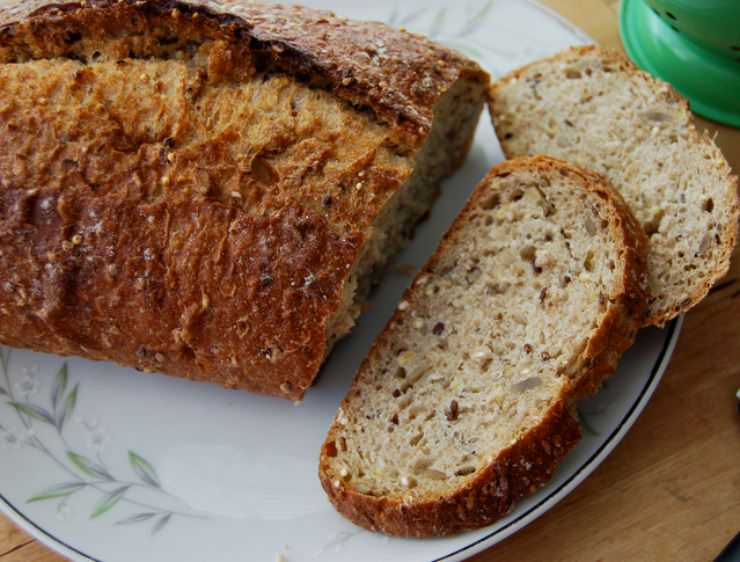 I realize the title of this post is rather shocking. I was floored too, when I first heard this information from Rami Nagel, author of Cure Tooth Decay, in a casual hallway conversation at a nutrition conference.
I realize the title of this post is rather shocking. I was floored too, when I first heard this information from Rami Nagel, author of Cure Tooth Decay, in a casual hallway conversation at a nutrition conference.
How could whole grains possibly cause cavities? I mean, whole grains are hard to digest, sure, but cavities?
Isn’t white bread, after all, one of the common causes of tooth decay because it is devoid of nutrition and basically white sugar dressed up as food? Isn’t white flour one of the “displacing foods of modern commerce” as written about by Dr. Weston A. Price in his groundbreaking work Nutrition and Physical Degeneration?
Dr. Price himself recommended consuming the entire grain (bran and germ) as have many health experts since his time. Scientific analysis of whole grains indicates a much higher level of minerals and overall nutrition than that of refined grains.
Based on scientific analysis alone, it seems clear that white bread should be avoided in the diet of those seeking nutrient dense foods and vibrant health. The health and condition of the teeth and mouth is a window to the body meaning that oral problems are the canary in the mine for problems brewing elsewhere. Note the strong link between periodontal disease and heart disease and stroke.
But, could there be something else going on here – something that a blind recommendation in favor of whole grains is missing?
Fact is, I know a number of folks that eat a whole foods diet including cod liver oil, never eat white bread and even go so far as to make their own whole wheat bread with fresh flour and they are still having cavity problems in the family.
Let’s dig beyond the sterile walls of a lab and see what else might be in play ….
Traditional Societies Did Not Typically Use the Whole Grain
The argument against whole grains stems from Rami’s claim that traditional societies did not usually make use of the entire grain. Rami has studied this issue in depth and has confirmed that the practice of removing the bran occurs traditionally in the French Alps with rye, in Africa with wheat and corn, and in Tibet with barley.
Why did these cultures remove the bran? Apparently, the practice occurs because the bran is loaded with plant toxins such as lectins that cannot easily be removed by sprouting, sour leavening, soaking or even cooking.
In the second edition of Cure Tooth Decay, Rami therefore recommends removal of the bran from wheat, spelt, rye, kamut, barley, corn, millet and oats through sifting or sieving.
Quinoa, buckwheat, and aramanth appear to be exceptions to this rule. Rice falls somewhere in between as traditional rice eating cultures typically removed some or all the rice bran before cooking. This was accomplished by pounding the rice into what is referred to as partially milled rice. I wrote about this in a past article which discusses why white rice is healthier than brown.
Once the Bran is Removed, What’s Next?
Rami goes further suggesting that whole grains must be soured first to significantly reduce phytic acid. Phytic acid is another big reason why grains cause cavities as this powerful anti-nutrient very effectively blocks mineral absorption in the gut. Phytic acid causes severe rickets when given to dogs as discovered and studied by researcher Edward Mellanby.
Rami’s research also indicates that sprouting grains does not reduce phytic acid significantly enough to make them safe for consumption.
In addition, Rami told me that soaking whole or sprouted grains in buttermilk, clabber, yogurt or kefir does not seem to reduce phytic acid content significantly. However, he did say that soaking will reduce phytic acid content but that plain, filtered water plus liquid whey is the best method for accomplishing this (substitute fresh lemon juice or apple cider vinegar for dairy free soaking).
What Are You Going To Do about Whole Grains?
I greatly respect Rami Nagel’s work and I think what he is discovering regarding tooth decay and healing tooth and gum problems in general is truly ground breaking. Therefore, I plan to adjust the preparation of grains in my own home based on our conversation that is summarized in this post. Here’s what I plan to do:
- Since I usually prepare my freshly ground grains by soaking in yogurt or kefir, I will immediately modify this approach to soaking in filtered water plus liquid whey instead. The rule of thumb for soaking is one cup of filtered water plus 1 TBL liquid whey per cup of flour mixed well together, covered and left overnight on the counter.
- I will begin sifting my flour to remove most of the bran before soaking.
- I will be sifting and then soaking my sprouted flour before baking since sprouting alone does not seem to reduce phytic acid content significantly.
- I had already switched years ago to white basmati rice from brown rice so no change needs to be made there.
What changes to your grain preparation techniques will you implement based on this information, if any? Please share your ideas.








Interesting! I actually don't do much baking so I hardly ever use flour. My husband has a wheat intolerance. I lived in Asia you years and tend to cook a lot of Asian foods. We're big rice eaters, but I prefer white rice and my husband prefers brown. I always soak my rice in water and apple cider vinegar overnight. Sometimes I soak it for several nights.
Hi Laura, my metal sieve is what I use as well. I don't know any way to do it faster but let me know if you find one!
What do you use to sift the flour? I'm new to all of this, and typically just use my metal sieve to sift as I go when a recipe calls for it. But is there a faster, easier way to sift?
I would also add that sprouting the flour first before soaking/sour leavening still holds tremendous nutritional advantage as it increases carotenes, B vitamins and vitamin C among other nutrients tremendously.
While perusing all the comments it occured to me regarding sprouted flour that since it does have a more nutrient dense profile compared to non sprouted flour perhaps you’ll still absorb a decent amount of the nutrients regardless of the phytate contents. Some interesting research I came across from http://www.rebuild-from-depression.com/soaking-grains
I am going to buy her “white paper” on the phytate topic.
Hi Anon, sprouted flour would need to be soured either by soaking or sour leavening as Rami has discovered that sprouting does not reduce phytates nearly as much as souring the dough does.
what about sprouted flour from to your health or the like?
Toni, that is a very good question. Rami did not specify this to me, but I would imagine coarser might be better. He did say that getting all the bran out is not necessary so if you are making a dish that requires a finer grain, that should be fine unless you are having tremendous cavity problems in which case you probably have already considered eliminating grains entirely for a time.
This is a very interesting article! I too really like your site Sarah! One question I have is would it be helpful to grind my grains using the coarser grind so as to sift out more easily the bran? I can't imagine that traditional cultures in past had the type of milling we do today and I would think that their grain would be much more coarse than ours.
Blessings,
Toni
I've been wondering and wondering about this. Beriberi (and the discovery of vitamin B) devastated Asia in the late 1800s with the advent of rice polishers (but maybe they parboiled, sending bran nutrients into the endosperm before that?), and the same with pellagra & corn in the US … but it seems people did sift.
Prior to, say, 1850, did Italians use whole or partially or fully sifted flour for their pasta? Did Native Americans use whole or sifted cornmeal for masa and their many other uses of corn? I just don't know. The answer will tell us what we need to know. Did Weston Price mean *really* whole grains, or just not industrially sifted? Does coarse grinding in traditional millstones (or even mortars/pilons/etc.) result in an easily siftable bran, or a flour that leaves some, but not all, of the brain attached?
We need the answer to these questions.
Meanwhile, I'm grain-free, and my (and my family's) health has never been better.
I don’t think pasta was a regular food for Italians before 1850. As far as I know, wheat was not used by farmers, but reserved for the upper classes.
As for corn, during the nixtamalization process, a lot of the bran and germ is broken down. It isn’t sifted as the entire grain is processed, unlike wheat, but you still end up with a semi-whole product. I’ve searched and searched for the exact amount of germ and bran removed, but have not been successful.
Also, during the nixtamalization process, traditional North and South American cultures used mineral ash for the process. Not only does this sufficiently break down the hull of the corn kernel (making the corn digestible and making minerals bioavailable), but the use of mineral ash significantly raises the mineral content of the corn. Nowadays, in most commercial corn masa facilities, slaked lime (i.e. Calcium Hydroxide) is used to remove the hull. This doesn’t have the same benefits as using mineral ash.
I spent 10 days in New Mexico recently, and I spent some time at a few very traditional Pueblos, learning the traditional cuisine. They still use the old mineral ash process, and I was taught how to use mineral ash for nixtamalization, as well as other traditional corn processing techniques. It was fascinating and educational!
Oh, and yes you are pretty much left with freshly ground white flour (but it is not refined as there are no fillers and synthetic vitamins added nor is it bleached). There is nutrition and fiber in the bran, yes, but it does more harm than good digestively which is why it is discarded according to Rami's research.